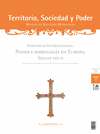Resumen
Resumen: El culto de la cruz nació en Jerusalén en el siglo iv. Su origen en Oriente, así como su expansión y desarrollo en Occidente a partir del siglo VIII, están ligados a la presencia de reliquias de la cruz. Ahora bien, para obtener una reliquia de la cruz fue preciso ante todo encontrarla. Por ello, el culto de la cruz no es comprensible sin su hallazgo, al que remiten las dos fiestas dedicadas a la misma, el 3 de mayo y el 14 de septiembre. La celebración litúrgica de los días en los que la cruz es el objeto principal del culto muestra una fuerte conexión, topográfica y temporal, con el contexto histórico. En Jerusalén, el recuerdo de la cruz está vinculado al lugar en el que murió y fue enterrado Jesús, y donde fue encontrada la cruz, y se fijó en el día en el murió Jesús, el Viernes Santo. A causa de la expansión de las reliquias se perdió la conexión topográfica con el lugar histórico, aunque se mantuvo la relación con el mismo materializado en la misma reliquia. Por el contrario, se conservó la referencia temporal al contexto histórico, ya que no hubo cambios en las fechas en las que se conmemoró la cruz. A lo largo del tiempo, el culto a la cruz el Viernes Santo se convirtió en un rito público cada vez más desarrollado, a la vez que desaparecía el rito original de la fiesta del 14 de septiembre, a lo largo de un proceso de creciente abstracción: la exaltación de la cruz se convirtió en una metáfora de la glorificación y exaltación del Señor, muerto en la cruz.
Palabras clave: fiestas de la cruz, Viernes Santo, Invención de la Cruz (3 de mayo), Exaltación de la Cruz (14 de septiembre), liturgia medieval, Jerusalén, Roma, liturgia franca, liturgia hispánica.
Abstract: The cult of the Cross came into being in Jerusalem in the fourth century. The origin of the cult of the Cross in the East as well as its spread and development in the West from the eighth century onwards are related to the presence of a relic of the Cross. But in order to have a relic of the Cross, it had to be found first. For this reason the cult of the Cross is inconceivable without the finding of the Cross in which the feasts of the Cross on 3 Mai and 14 September originate. The liturgical celebration of the days on which the Cross is the main theme, shows a strong topographical and temporal connection of the cult of the Cross to the historical setting. In Jerusalem the remembrance of the Cross was located on the site on which Jesus died and was buried and where the Cross was found, and it took place on the day on which Jesus died, Good Friday. Because of the spread of the relic the topographical connection to the historical place was abandoned. But the reference to the historical place became materialised in the relic. The temporal reference to the historical context was preserved because the dates on which the Cross was commemorated were not changed. In the course of time on Good Friday the cult of the Cross developed to a more and more elaborated public ritual, while the original ritual on the feast of 14 September disappeared and had become abstract; the exaltation of the Cross became a metaphor for the glorification and exaltation of the Lord, who died on the Cross.
Keywords: Feasts of the Cross, Good Friday, Finding of the Cross (3 Mai), Exaltation of the Cross (14 September), Medieval liturgy, Jerusalem, Rome, Frankish liturgy, Spanish liturgy.

